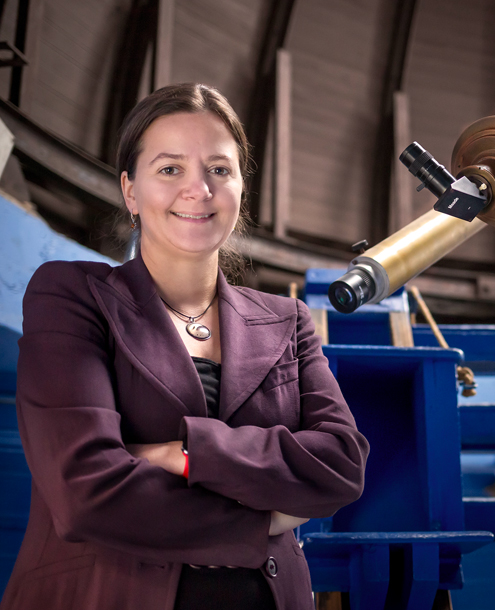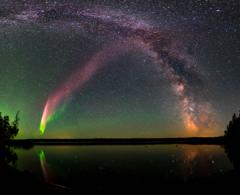
This Article From Issue
September-October 2018
Volume 106, Number 5
Page 282
Tabetha Boyajian, an assistant professor of physics and astronomy at Louisiana State University, has joined with the citizen science project Planet Hunters to investigate a mysterious star, KIC 8462852, also known as Tabby’s Star or the Where’s the Flux? (WTF) Star. The star’s unique dimming activity has led scientists and amateur astronomers to consider explanations outside the norm, including the possibility of alien megastructures. Special issue editor Corey S. Powell spoke with Boyajian about this unusual star and the role of citizen scientists in her research.

Tabetha Boyjian
How did this particular star come to your attention?
Volunteers on Planet Hunters had flagged one star as not looking like any other star. There were lots of ideas being passed back and forth online about what was going on, but nothing was really satisfying. They couldn’t explain it.
When I looked at it, I thought, “That’s clearly not anything that we know stars do. The data have to be bad.” It was at that point that the whole citizen science magic kicked in. The folks who pointed it out to us said, “We’ve checked to see if the data were bad, and we don’t see any red flags. It’s worth another look.”
When you first look at this light curve from Kepler, any scientist would say, “No, that’s not real.” They won’t even think about it, because it’s really crazy-looking. But that’s the magic of citizen science and thinking outside of the box. They spotted it, and because it wasn’t periodic, it wouldn’t have come up in any trends or searching algorithms.
If the standard algorithms looking for planets didn’t turn it up, how did the Planet Hunters notice that the star was doing something unusual?
We show a 30-day chunk of data to five to 10 people. For this star, the features are large enough that it sticks out like a sore thumb. It’s not something that a transiting-planet-hunting algorithm would pick out, because for that you need something that repeats periodically, and this does not. The human eye can pick it out very easily, though.
How long did it take you to convince yourself that what you were seeing was real, that it was not corrupt data?
Quite a while [laughs]. And everybody I talked to had to go through the same steps of convincing themselves that it was real. If you’re calling to ask somebody for ground-based follow-up observations, if you want a spectrum from the Spitzer telescope, you’d better be damn well sure that it is not a false positive. That’s really expensive telescope time. And so with everybody who interacted with it over the years, we had to play this game: “This is what we see. This is why we think what we think. These are all the people who have verified that the data are not just corrupt in some way.”
You always think that you’re missing something obvious. There are 49 authors on the discovery paper. We had all looked at it in every way we could think of, but there was still this possibility that there was a simple explanation, and once it came out we’d all look like fools. But month after month went by, and it proved the test of time. I guess it was a gradual acceptance that this was really weird. It’s really exciting, but it’s also very frustrating, as you can imagine, working on something for so long and not being able to get closer to an answer.
What have you learned so far?
We had a bunch of dimming events that started in 2017 up until last month [March 2018]. One event lasted for about a week, and it had a 2 percent drop [in brightness]. It was chromatic. This tells us that whatever material is passing between us and the star has the same signature as dust, meaning that it blocks blue light more efficiently than it does red light. We were also able to tell that there were no signs of any infrared excess [infrared radiation resembling that from dust warmed by the star] during the event. There were no peculiar signs in the spectra, either at the spectral lines [chemical fingerprints in the star’s light] or with radial velocities. We were able to look at the polarimetry [how the dust polarizes light] during the event, to study the surrounding area, and we didn’t see anything out of the ordinary there. All these observations put up a picture of what things were like during an event that was a very, very special time, especially being able to measure the colors of it.
Where are you in starting to crack the code of this star?
We came to a conclusion that the dimming does look like dust, but that was kind of the whole point of where we were before. Assuming that it’s something in front of the star, then what could it be? Dust is always the naturally occurring explanation, but there’s no infrared excess, so it can’t be dust— hence aliens! Or it’s some kind of magical dust.
We don’t know how this dust is generated. We don’t know where it is. We don’t know how you can get the shapes of the dips that we’re seeing. And there’s also this long-term dimming that doesn’t fit into the story. We have something that we can really latch onto—it looks like dust, but it doesn’t look like any dust that we know of.
There is an idea that it could be caused by something internal to the star, like perhaps some kind of star spots, which leads to blocked convection [which traps energy inside]. I have a hard time wrapping my head around that. If you have a star spot, you should have some sort of rotational modulation. This star spins about once a day. I don’t understand why that’s not there, and what would invoke a unique scenario to happen with this one star. All stars have convection as long as they’re cool enough and there are atmospheres. Why don’t all the other stars have these sorts of phenomena?
Is there anything upcoming that would help you find another object like this, if there’s another one like it out there?
There are several promising things on the horizon. We have four years of Kepler data and we only have two very large events. That’s a fraction of a percent of those four years. To actually catch something when it’s happening is going to be quite tricky, to find an analog to something like this. Something like the TESS mission will give, at most, one year of continuous coverage of a certain object, or a group of objects. And I don’t know if that would be enough to find something analogous to this star.
But there’s also mountains of already-existing archival data from smaller telescope arrays and networks that I think will be gold mines for us to be sifting through in the next few years, especially with respect to big data, trying to look for unique objects like this. Whether you have citizen scientists sifting through the data, or now that we think we’ve locked on something that would be interesting, and you can quantify it in some way, we’ll be able to train an algorithm or use an AI of some sort that is looking for things that aren’t like everything else.
Where does your team go from here?
Finding out whether whatever is happening is periodic will be key to us understanding what’s going on. Because things that have periods have a solution. The period of whatever is happening here is not immediately obvious with the four years of Kepler data we have and the couple of years of ground-based monitoring. We’re just going to have to sit on it and wait longer. That’s what I’ve made my priority, to just have this photometric monitoring be continued, to track both the short-term dimming events and the long-term specular dimming as well.
Citizen scientists provide financial support for the long-term observation of the WTF Star through crowdfunding. It must have been gratifying to realize that there was enough public support that you could buy the observing time you needed.
It was very overwhelming. You have this group of supporters—everyone rooting you on in a way that, if you get a grant from the government, you don’t really have that at all. Who’s there on the other end, really interested in the science that you’re going to do with your grant money? This was pretty awesome, to have the support from the general public, and to have folks who could talk about it and educate people about what was going on. I think that was probably one of the luckiest things that I got to be a part of.
Are you continuing to work with citizen scientists?
The star was found by citizen scientists, and so keeping that theme alive, that’s one of the things that really jives with the Kickstarter project. You can have citizen scientists contribute to this science, getting more observations. There’s a subreddit for this star. Probably the only star to have its own subreddit. The moderators on there, I think they’re mostly citizen scientists. And so it’s not just going through the data. It’s several different kinds of ways that you can look at the whole problem. There are the Kickstarter backers and the moderators on Reddit. There’s also the amateur observers, the folks who are fortunate enough to have their own telescopes and facilities and do nightly observations on their time.
We are trying to—as far as the Planet Hunters web interface—we’re trying to give that a jump start. Especially with the TESS mission coming on line. I think that will be a really sweet spot for finding interesting things, especially if you have a 30-day chunk of the light curve and you have a planet with a longer-than-30-day orbital period. A citizen scientist would be able to pick out a signal like that pretty easily and flag it for follow-up. A computer will have trouble finding a single event because it doesn’t repeat. We’re really keen on folding TESS data into Planet Hunters.
Right now, we need more people on the science team side of it. It will happen. I have faith that it will happen. We’re working on putting a good, solid team together, because there is so much interest in finding exoplanets. We’re also really interested in opening up data to be more public—data and the whole scientific process—because there has been this public pushback on science. We could open it up a little bit more so that it will hopefully pass on the impression that, no, we’re not trying to hide something, but actually we could benefit from the help of everybody in answering some of these questions.
I am lucky. I realize that I’m very, very lucky to do what I do and be able to ask these questions. It just takes some conditioning to realize that the whole process can be frustrating. But it’s way rewarding in the end.

American Scientist Comments and Discussion
To discuss our articles or comment on them, please share them and tag American Scientist on social media platforms. Here are links to our profiles on Twitter, Facebook, and LinkedIn.
If we re-share your post, we will moderate comments/discussion following our comments policy.